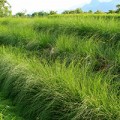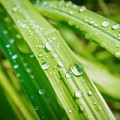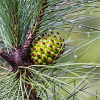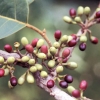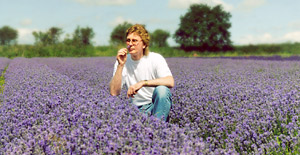Tuberose Absolute
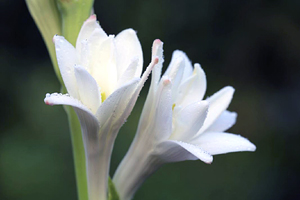 For over 100 years, tuberose was one of the most expensive natural flower materials available to the perfumer, and was quite literally, worth its weight in gold.
For over 100 years, tuberose was one of the most expensive natural flower materials available to the perfumer, and was quite literally, worth its weight in gold.
This was due to the excruciatingly slow and laborious method of obtaining tuberose oil known as ‘cold enfleurage’.
This method is far too time consuming for our modern world, so thanks to improvements in extraction techniques and cultivation, the price of tuberose absolute is now more affordable than the oil originally obtained by enfleurage.
Despite the reference to ‘rose’ within its name, tuberose has no relationship with the rose whatsoever, and is in fact, related to Narcissus and Jonquil. And in case you were curious, a tuber is an underground root or stem which serves as a food storage organ and can be flat, rounded or irregular in shape. This plant has a tuber, therefore this is where part of its name is derived from.
Tuberose origins
Tuberose (Polianthes tuberosa) is believed by botanical experts to be native to Central America, although precisely where it originated has not yet been determined. Whatever its source, the tuberose was already domesticated by the indigenous civilizations of Mexico when they were conquered by the Spanish conquistador Hernando Cortez and his army in 1521.
When the Spanish conquerors returned home, they took the fragrant tuberose with them where it soon became highly prized, and could be found gracing gardens and courtyards everywhere. It was also carried on the Spanish galleons travelling out of Central America in search of new worlds, and eventually found its way to India, although exactly how or when it arrived is also a mystery.
Between the years of 1920 to the late 1950’s, France was the worlds leader of tuberose cultivation for oil production, but after this France’s output fell dramatically. Today tuberose is grown for its fragrant oil in South Africa, China, Comores Islands, Egypt, India, Morocco and the USA.
Physical description
Tuberose is an annual plant which appears to adapt under tropical conditions to become a tender perennial, thereby not displaying its beautiful flowers until their second year of growth. The bright green leaves are 70-80 cm long (2ft 4ins –2ft 8ins), narrow, linear and grass-like. The flowering stalk which emerges from the centre of the cluster of leaves can reach a height of 92 cm (3ft), bearing successively smaller long pointed clasping leaves, the uppermost ones are much reduced and bract-like.
The stalks are topped with ivory or waxy-white star-shaped flowers that are 5-6 cm long (2-2.5ins) and arranged in magnificent clusters. The 6 petalled flowers emit a beautiful, creamy, honey-like, spicy fragrance that is truly captivating and intoxicating.
Folklore and traditional uses
Tuberose is a fragrant night-blooming flower as can be witnessed from the various colloquial names used to describe it wherever it grows around the world. The Hindi name for tuberose is Rajnigandha which means ‘night fragrant’, and the legend of the tuberose warns young Indian girls against inhaling its sensual fragrance after dark because it may put them in the mood for love. Its Bengali name is Rojoni-Gondha meaning ‘scent of the night’ and in China tuberose is known as WanXiangYu which translates into ‘night fragrance’.
The ancient Aztec healers called tuberose Omixochitl which means ‘bone-plant’ because of its waxy white-grey colour. They used it in traditional medicine making excellent use of its antiseptic, analgesic, anti-inflammatory and anti-spasmodic properties. It was also employed for its aphrodisiac and narcotic properties too.
Harvesting and extraction
In France, tuberose usually flowers between June and September, and in India mainly between October and November. In both locations harvesting begins at sunrise and only the blossoms that are just beginning to unfold are collected, since flowers that are already open will quickly lose their precious oil and wither after cutting. The unopened buds still continue to produce essential oil after gathering, consequently the timing of the distillation is absolutely crucial since this developing oil would be lost if the buds are processed either too soon, or too late.
Steam distillation is unable to capture the full aroma of tuberose blossoms, so like many flower oils it is obtained by solvent extraction which is far more efficient at extracting a wide spectrum of the plants fragrant molecules. This method produces a dark orange-brown viscous absolute which congeals at cool temperatures due to the presence of natural waxes. The captivating aroma is deep, rich, sweet floral with honey and spicy undertones, and a little reminiscent of honeysuckle.
Benefits of tuberose absolute
Tuberose absolute is not widely used in aromatherapy since it is still quite costly, but due to its powerfully rich and intoxicating fragrance, a little tuberose absolute goes a very, very long way in aromatherapy. Some of its therapeutic properties reported by various authors include antidepressant, anti-inflammatory, aphrodisiac, carminative, meditative, narcotic, relaxant, sedative, sensual, uplifting making it useful with anxiety, depression, fear, frigidity, impotence, impatience, inflammation, irritability, lethargy and stress.
On an emotional level tuberose absolute is useful whilst going through unexpected and unpleasant changes in life. Associated with the root chakra, it is an extremely grounding, fortifying and empowering oil which helps us stay with our feet firmly on the ground whilst we deal with turbulent times. It is effective also for dispelling depression, anxiety and negativity, offering support throughout a transformation of character. This makes tuberose ideal for treating obsessive behavioural problems.
If, like me, you enjoy practicing the frustrating and challenging art of natural perfumery, you will find tuberose absolute invaluable in floral-type creations. It has a very powerful, diffusive aroma, and only a tiny amount is needed to add a rich, creamy, floral warmth to blends. Although tuberose is considered to be a middle note, in common with rose, jasmine and neroli it is almost a complete fragrance in itself providing the oil has been extracted correctly.
When blending, try it with bergamot, cardamon, clove bud, grapefruit, jasmine, lavender, lemon, neroli, rose, sandalwood, vanilla, violet leaf and ylang ylang.
Copyright © Quinessence Aromatherapy Ltd 2018.

